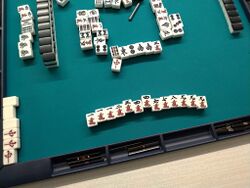Chuuren poutou: Difference between revisions
No edit summary |
mNo edit summary |
||
| Line 13: | Line 13: | ||
* [http://tenhou.net/0/?log=2013102709gm-0009-7447-dce693b1&tw=0&ts=11 Missed chuuren] | * [http://tenhou.net/0/?log=2013102709gm-0009-7447-dce693b1&tw=0&ts=11 Missed chuuren] | ||
}} | }} | ||
'''Chuuren poutou''' {{kana|九連宝燈}} is a [[ | '''Chuuren poutou''' {{kana|九連宝燈}} is a [[yakuman]] scored when a hand contains the 13-tile pattern of: 1-1-1-2-3-4-5-6-7-8-9-9-9 of the same suit, plus any one tile from the same suit. In addition, the hand must be closed. Calling a [[kan]] on the 1 or 9 invalidates the yakuman. | ||
A special pattern of chuuren [[tenpai]], '''junsei chuuren poutou''' {{kana|純正九蓮宝燈}} ("pure churren poutou"), results in a 9-sided wait. It occurs when you complete the 1-1-1-2-3-4-5-6-7-8-9-9-9 pattern without any duplicate tiles. Unlike the 13-sided [[kokushi musou]], this 9-sided wait is formed naturally with four sets and a pair. Some [[yaku variations|rule variations]] consider this a [[double yakuman]]. | A special pattern of chuuren [[tenpai]], '''junsei chuuren poutou''' {{kana|純正九蓮宝燈}} ("pure churren poutou"), results in a 9-sided wait. It occurs when you complete the 1-1-1-2-3-4-5-6-7-8-9-9-9 pattern without any duplicate tiles. Unlike the 13-sided [[kokushi musou]], this 9-sided wait is formed naturally with the four sets and a pair. Some [[yaku variations|rule variations]] consider this a [[double yakuman]]. | ||
==Tile pattern== | ==Tile pattern== | ||
Revision as of 23:38, 23 August 2024
| Type | Yakuman |
|---|---|
| Kanji |
九連宝燈 純正九蓮宝燈 |
| English |
Nine gates Pure nine gates |
| Value | Yakuman (closed only) |
| Speed | Very slow |
| Difficulty | Very hard |
Chuuren poutou 「九連宝燈」 is a yakuman scored when a hand contains the 13-tile pattern of: 1-1-1-2-3-4-5-6-7-8-9-9-9 of the same suit, plus any one tile from the same suit. In addition, the hand must be closed. Calling a kan on the 1 or 9 invalidates the yakuman.
A special pattern of chuuren tenpai, junsei chuuren poutou 「純正九蓮宝燈」 ("pure churren poutou"), results in a 9-sided wait. It occurs when you complete the 1-1-1-2-3-4-5-6-7-8-9-9-9 pattern without any duplicate tiles. Unlike the 13-sided kokushi musou, this 9-sided wait is formed naturally with the four sets and a pair. Some rule variations consider this a double yakuman.
Tile pattern

Regular
If this hand wins with either of the yasume tiles, the hand will score only chinitsu rather than the yakuman.
Nine tile wait
In the above animation, the different winning tiles show the shifting tile group configurations as they count up 1 through 9. The groupings change with each winning tile. Sequential groups are marked in green, while the indicated pairs are marked blue. Then in red, the 1 or 9 indicated as triplets.
Value
Chuuren is a yakuman hand. However, while tenpai, some tile waits may actually award the hand for a considerably less value of haneman, as a closed chinitsu. Some rules award a double yakuman instead when the hand goes out from the 9-sided wait.
Development
Since this hand is made up of one suit, it overlaps with chinitsu during development. In fact, many tenpai formations may result in chinitsu instead of the yakuman.
The key to this yakuman is the possession of ankou of both 1's and 9's of one suit. If two copies of either 1 or 9 are unavailable, then the yakuman becomes impossible. Similarly, if all four of any other numbered tile is unavailable, then it also becomes impossible. Of course, gathering a string of 2-8 is also difficult.
External links
- Chuuren poutou in Japanese Wikipedia
- Mathematical study
- Chuuren (YouTube)
- Kojima Takeo
| |||||||||||||||||||||||||||||||
| ||||||||||||||||||||||


